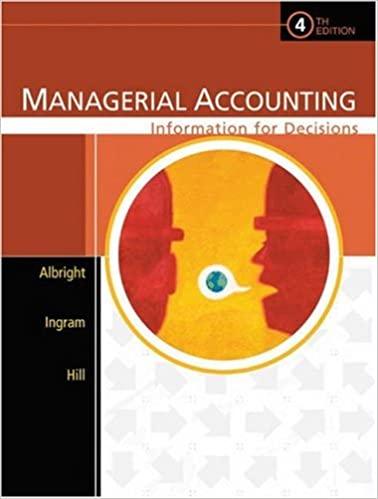1. During May 2003, Bennett Manufacturing Company purchased ($ 43,000) of raw materials. The company's manufacturing overhead...
Question:
1. During May 2003, Bennett Manufacturing Company purchased \(\$ 43,000\) of raw materials. The company's manufacturing overhead for the month totaled \(\$ 27,000\) and the total manufacturing costs were \(\$ 106,000\). Assuming a beginning inventory of raw materials of \(\$ 8,000\) and an ending inventory of raw materials of \(\$ 6,000\), direct labor must have totaled:
a. \(\$ 34,000\).
b. \(\$ 38,000\).
c. \(\$ 36,000\).
d. \(\$ 45,000\).
2. The wages of the maintenance personnel in a manufacturing plant are an example of:

3. The distinction between indirect and direct costs depends on:
a. whether the costs are product costs or period expenses.
b. whether the company has paid for the resource consumed.
c. whether the costs can be easily traced to specific units of production.
d. the manager responsible for controlling the cost.
4. The Rockin Roller Company manufactures rocking chairs. The following costs have been identified with rocking chairs produced during the current month:
- \(\$ 100,000\) of springs were purchased and used. Each chair requires 2 springs at a cost of \(\$ 10\) per spring.
- \(\$ 1,700\) of glue was used from one-gallon containers.
- \(\$ 500\) of stain was used to touch up spots on the chairs.
The total amount of indirect materials for the month would be:
a. \(\$ 102,200\).
b. \(\$ 500\).
c. \(\$ 2,200\).
d. \(\$ 1,700\).
5. Product costs appear on the balance sheet only:
a. if goods are partially complete at the end of the period.
b. if goods are unsold at the end of the period.
c. if raw materials used to make the goods have been paid for.
d. Both \(\mathrm{a}\) and \(\mathrm{b}\) are correct.
6. The value chain for a given product or service:
a. reflects all activities associated with providing the particular product or service.
b. identifies non-value-adding activities that should be eliminated or reduced.
c. includes activities both inside and outside the company.
d. All of the above are correct.
7. Costs flow through an accounting system as follows:
a. raw materials, work in process, cost of goods sold, finished goods.
b. finished goods, cost of goods sold, work in process, raw materials.
c. raw materials, work in process, finished goods, cost of goods sold.
d. raw materials, finished goods, cost of goods sold.
8. Target costing begins with a:
a. target cost to which a markup is added.
b. selling price from which a required margin is subtracted.
c. required margin that is added to a target cost.
d. selling price to which a markup is added.
9. The target cost calculation involves understanding the relationship among three variables:
a. target cost, required profit margin, and selling price.
b. selling price, target cost, and gross profit.
c. gross profit, selling price, and cost of goods sold.
d. target cost, selling price, and dividends.
10. Service organizations are different from manufacturing companies.
a. Thus, product costing techniques are not relevant to them.
b. Service costs are reported as a cost of services provided.
c. Service organizations classify their costs as direct and indirect.
d. Both b and c are correct.
Step by Step Answer:

Managerial Accounting Information For Decisions
ISBN: 9780324222432
4th Edition
Authors: Thomas L. Albright , Robert W. Ingram, John S. Hill





